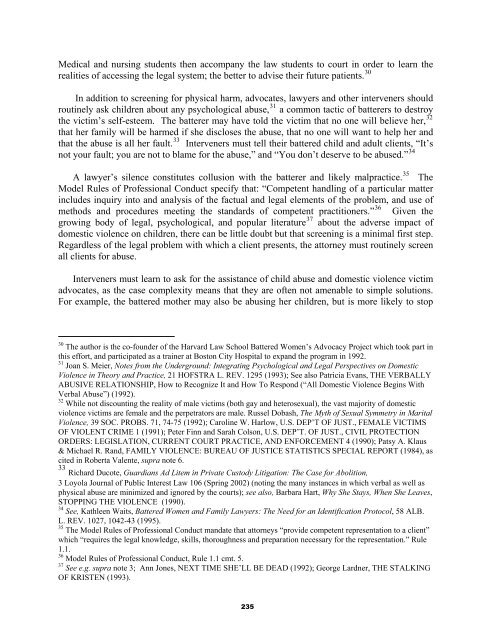A Judge’s Guide
A Judge’s Guide
A Judge’s Guide
Create successful ePaper yourself
Turn your PDF publications into a flip-book with our unique Google optimized e-Paper software.
Medical and nursing students then accompany the law students to court in order to learn the<br />
realities of accessing the legal system; the better to advise their future patients. 30<br />
In addition to screening for physical harm, advocates, lawyers and other interveners should<br />
routinely ask children about any psychological abuse, 31 a common tactic of batterers to destroy<br />
the victim’s self-esteem. The batterer may have told the victim that no one will believe her, 32<br />
that her family will be harmed if she discloses the abuse, that no one will want to help her and<br />
that the abuse is all her fault. 33 Interveners must tell their battered child and adult clients, “It’s<br />
not your fault; you are not to blame for the abuse,” and “You don’t deserve to be abused.” 34<br />
A lawyer’s silence constitutes collusion with the batterer and likely malpractice. 35 The<br />
Model Rules of Professional Conduct specify that: “Competent handling of a particular matter<br />
includes inquiry into and analysis of the factual and legal elements of the problem, and use of<br />
methods and procedures meeting the standards of competent practitioners.” 36 Given the<br />
growing body of legal, psychological, and popular literature 37 about the adverse impact of<br />
domestic violence on children, there can be little doubt but that screening is a minimal first step.<br />
Regardless of the legal problem with which a client presents, the attorney must routinely screen<br />
all clients for abuse.<br />
Interveners must learn to ask for the assistance of child abuse and domestic violence victim<br />
advocates, as the case complexity means that they are often not amenable to simple solutions.<br />
For example, the battered mother may also be abusing her children, but is more likely to stop<br />
30<br />
The author is the co-founder of the Harvard Law School Battered Women’s Advocacy Project which took part in<br />
this effort, and participated as a trainer at Boston City Hospital to expand the program in 1992.<br />
31<br />
Joan S. Meier, Notes from the Underground: Integrating Psychological and Legal Perspectives on Domestic<br />
Violence in Theory and Practice, 21 HOFSTRA L. REV. 1295 (1993); See also Patricia Evans, THE VERBALLY<br />
ABUSIVE RELATIONSHIP, How to Recognize It and How To Respond (“All Domestic Violence Begins With<br />
Verbal Abuse”) (1992).<br />
32<br />
While not discounting the reality of male victims (both gay and heterosexual), the vast majority of domestic<br />
violence victims are female and the perpetrators are male. Russel Dobash, The Myth of Sexual Symmetry in Marital<br />
Violence, 39 SOC. PROBS. 71, 74-75 (1992); Caroline W. Harlow, U.S. DEP’T OF JUST., FEMALE VICTIMS<br />
OF VIOLENT CRIME 1 (1991); Peter Finn and Sarah Colson, U.S. DEP’T. OF JUST., CIVIL PROTECTION<br />
ORDERS: LEGISLATION, CURRENT COURT PRACTICE, AND ENFORCEMENT 4 (1990); Patsy A. Klaus<br />
& Michael R. Rand, FAMILY VIOLENCE: BUREAU OF JUSTICE STATISTICS SPECIAL REPORT (1984), as<br />
cited in Roberta Valente, supra note 6.<br />
33<br />
Richard Ducote, Guardians Ad Litem in Private Custody Litigation: The Case for Abolition,<br />
3 Loyola Journal of Public Interest Law 106 (Spring 2002) (noting the many instances in which verbal as well as<br />
physical abuse are minimized and ignored by the courts); see also, Barbara Hart, Why She Stays, When She Leaves,<br />
STOPPING THE VIOLENCE (1990).<br />
34<br />
See, Kathleen Waits, Battered Women and Family Lawyers: The Need for an Identification Protocol, 58 ALB.<br />
L. REV. 1027, 1042-43 (1995).<br />
35<br />
The Model Rules of Professional Conduct mandate that attorneys “provide competent representation to a client”<br />
which “requires the legal knowledge, skills, thoroughness and preparation necessary for the representation.” Rule<br />
1.1.<br />
36<br />
Model Rules of Professional Conduct, Rule 1.1 cmt. 5.<br />
37<br />
See e.g. supra note 3; Ann Jones, NEXT TIME SHE’LL BE DEAD (1992); George Lardner, THE STALKING<br />
OF KRISTEN (1993).<br />
235


